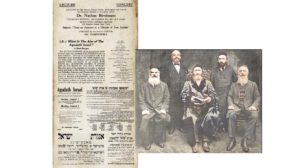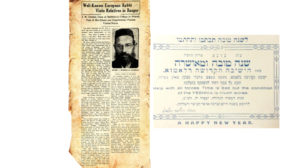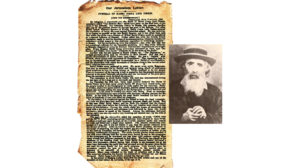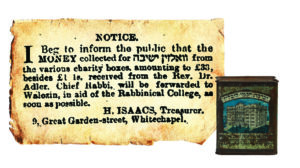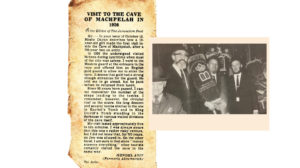Forever a Fighter

Eliyahu Abramson passed away just a few short months before the 75th anniversary of D-Day. But from Omaha Beach to Aish HaTorah, his life was one long miracle
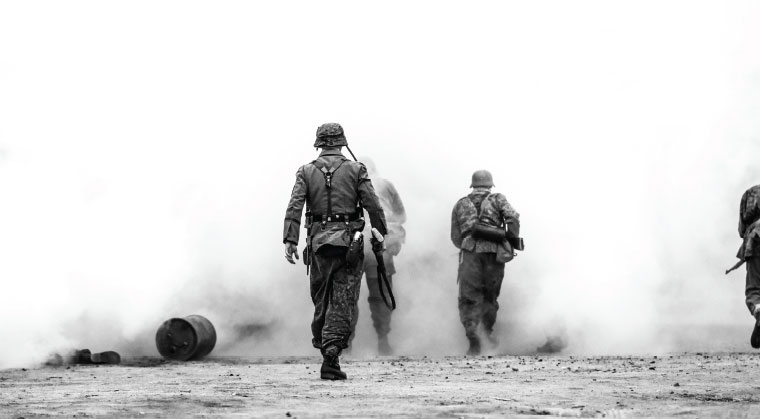
Photos: Family archives
W
e are a forward-looking people, full of optimism and hope. So why look back? Why waste precious moments of “now” to tell stories of long ago? That was the hurdle the family of Eliyahu (Edward) Abramson a”h had to overcome, as they begged the 97-year-old father, grandfather, and great-grandfather to tell his story.
When he greeted visitors on a winter Sunday, Eliyahu Abramson was recuperating from a broken left leg. Neither his injury nor his 97 years got in the way of his vigorous hospitality. He engaged in easy banter, and the atmosphere was light and friendly — at least until the idea of an interview was introduced.
He insisted that anyone who was not there will never understand. Still, he conceded that at least some part of the story needed to be recorded, for the sake of future generations. Reluctantly, he dusted off memories of war and death as an American soldier during World War II, as well as the wonder of being a Jew in Eretz Yisrael and reclaiming his Torah heritage. As the narrative took shape, he agreed to plans for a photographer to come that Friday.
Unfortunately, that photography session never came to pass; Eliyahu was admitted to the hospital with a fever, and, except for one brief interval, remained there until 6 Adar II/March 13 — when he returned his soul to his Maker, having completed his assignment in This World.
While the French government is nearly done processing the paperwork for his Legion of Honor medal, that is likely not the lifetime accomplishment that Eliyahu would emphasize. Rather, it would be the legacy of sixteen Torah-observant great-grandchildren, left by someone who started out life as a secular Jew.
This is his story.
Unsung Hero
Sword. Juno. Gold. Utah. Omaha. Today, those names mean little to most people. But these code names for different landing points along a 60-mile stretch of coastline in Normandy, France, proved to be a turning point in the fortunes of the Allied forces during World War II. In the early hours of June 6, 1944 — D-Day, as it is famously known — British, Canadian, and American troops attempted to land and break through the Nazi stranglehold on occupied France and thereby gain access to the rest of Europe.
By the end of the day, the advance forces had partially accomplished their mission and achieved a tenuous foothold on French soil, enabling more than 150,000 troops to successfully land. By the end of June, over a million Allied soldiers had been shipped into France. But in the beginning, strong winds and even stronger German resistance turned the coast into a graveyard for thousands of Allied soldiers, and it looked like the invasion of Normandy was going to be a colossal disaster.
The worst of the fighting occurred on Omaha Beach, where according to some estimates over 1,000 Americans died and another 1,400 were wounded. Many drowned as landing craft foundered in deep water. Others, too badly wounded to move to safety, drowned in shallow water. As for those who managed to make it to shore, German pillbox emplacements, located on cliff tops and fortified behind thick concrete walls, rained down a steady hail of machine gun fire on anyone who dared to raise his head.
Twenty-two-year-old sergeant Edward Abramson was among the American soldiers fighting his way through the bloody, chaotic inferno. With dead and wounded all around him, he was pinned down by a German machine gun aimed in his direction. Then, miraculously, the firing stopped. Inching up to the machine gun location, he looked in through the firing slit: The machine gunner was dead. Someone had dropped a grenade through the narrow opening.
Abramson survived the battle that day, other days on that deadly beach, and elsewhere — an unsung hero, but still a member of what has been dubbed America’s greatest generation. Still, a person could ask, what was a nice Jewish-American boy doing in a place like Omaha Beach?
Pearl Who?
Eliyahu Abramson began the story of his life by explaining that he wasn’t supposed to have been born. His proof? In 1916, in the United States of America, Yiddish-speaking, 20-year-old Mania (Minny), recently from Russia, married 20-year-old Yiddish-speaking Yosef, recently from Poland. But according to the rules of logic, the marriage wasn’t supposed to have taken place. The travel papers for America were for Minny’s sister, but the sister couldn’t travel, so Minny took her place. The rest was history for little Eliyahu, the couple’s second son, who was born on January 15, 1922.
Yosef was a tailor employed by the West Point Military Academy. The young couple therefore settled in nearby Newburgh, New York. Living any sort of Jewish life in Newburgh was very difficult when there were so few Jews living in the town. Eliyahu could recall only two other Jewish families. “I grew up in Newburgh as a secular Jew,” he commented.
But Minny tried to maintain a Jewish home and instill a Jewish consciousness in her children. “What we ate was selected very carefully,” Eliyahu explained. “There were no kosher markets in Newburgh. But I have vivid memories of my mother taking me to a food store and pointing out the OU hechsher on a can of Heinz beans. She told me, ‘If I ever send you to the store, these are the cans to buy.’ (In 1923, Heinz vegetarian beans became the first product certified by the OU.)
“My mother also frequently spoke to me about being Jewish, telling me in Yiddish, ‘Don’t you ever forget that you are Jewish.’ ”
Years later, his superior officer told sergeant Abramson to change his identifying dog tags with the prominent “H” designation. Identification as a Hebrew/Jew would spell death should he be captured by the Germans. But he kept his “H” designation. He refused to forget that he was a Jew, not even on his dog tags, which he afterward kept in a prominent place in his home.
In 1941, Edward, as he was then called, moved to California to attend UCLA. But his schooling was interrupted by the bombing of Pearl Harbor.
“I remember sitting on the front porch on a beautiful sunny Sunday in December,” he recalled. “The front door was open, and the radio was on. We suddenly heard the announcer yelling that Pearl Harbor was being bombed. I really didn’t know where Pearl Harbor was. But then President Roosevelt came on and said that the next day he was going to ask Congress to declare war on Japan. You never forget a thing like that.”
You’re in the Army Now
On December 8, the United States declared war on Japan. Three days later, Japan and its Axis allies — Germany and Italy — declared war on the United States.
It was obvious to 19-year-old Edward that he would soon be drafted into the Army. But he didn’t want to be a foot soldier; the Air Force was so much more glamorous. “I wanted to be a hot-shot pilot,” as he put it. So, he quickly returned to Newburgh to enlist in the Air Force (then known as the US Army Air Forces; it became an independent service branch in 1947).
Of course, the Air Force didn’t accept somebody just because he wanted to serve. There was a qualifying exam, which Edward passed — that should have meant he was going to the Air Force. Instead, he received notice that he’d been drafted into the Army. Upon reporting at the recruiting office, he explained that he had been accepted to the Air Force. No problem, a smiling officer told him. Just go through the basic training and you can switch to the Air Force later.
He did as he was told, did well in his training, and finished with the rank of corporal. He also learned that once you’re in the Army, you stay in the Army. But Edward didn’t give up. He contacted a colonel who intervened and arranged for his transfer to the Air Force. Then came more training and classes, which Edward handled well, followed by the group’s combat orders.
Everything seemed to be going according to plan — at least Edward’s plan. But then one day he was walking in the street with a friend and he suddenly felt terrible abdominal pains. At a nearby hospital he was diagnosed with a soon-to-burst appendix. After surgery and two weeks recuperating, Edward was ready to rejoin his Air Force unit. But they were nowhere to be found. Furthermore, the bureaucracy had discovered that Edward had finished Army basic training, and assigned him to a combat unit. This time he couldn’t get out of it. After more advanced training — Edward finished with the rank of sergeant — he and his unit were ready to be shipped to Europe.
The Atlantic crossing on the Queen Mary, which had been converted into a transport vessel for the war effort, was unexpectedly luxurious, Abramson recalled. The soldiers were ordered to board the ship in reverse alphabetical order, which meant Edward was last in line. Suddenly there was a shout: “Stop!” There was no more room in the hold, where the soldiers were squeezed in like sardines. But they had to get everybody on board, and so sergeant Abramson was assigned a stateroom among the VIPs.
Close Encounters
Looking back, Edward pointed out that what had seemed a great disappointment at the time — his frustrated desire to be an Air Force pilot — may have saved his life. After the United States entered the war, the Air Force and Navy were the first to see combat. More than 80,000 American airmen died during the war, and tens of thousands became prisoners of war.
Of course, the Army’s ground forces suffered heavy casualties as well, and over 100,000 GIs became prisoners of war. But thanks to the lengthier training Edward received in the Army, he saw active combat for just one year.
That was bad enough, he commented. In a year, a soldier could encounter numerous near-death experiences. Approximately 37,000 Allied soldiers were killed during the month-long invasion of Normandy —and that was just one battle.
For Edward, memories of his introduction to combat at Omaha Beach remained vivid for the rest of his life. One image he could never forget was that fortified pillbox — a bunker with thick concrete walls and a small opening for a machine gun to spit out its bullets.
“The gunners were shooting and killing hundreds of American soldiers,” Edward recalled. “I saw a howitzer shoot point-blank at the pillbox and nothing happened. But one man crept up underneath, just one man, and lobbed a grenade in. Amazing! He saved many lives.”
Eventually an exhausted Edward found shelter under a tree, hoping to take a short rest. Instead, he was in the line of fire of the deadliest gun in the German arsenal, the 8.8-centimeter Flak gun, which was used mostly for anti-aircraft and anti-tank warfare. It fired a 17-pound shrapnel grenade in the form of a long bullet that could tear an aircraft to pieces — never mind what it would do to a person.
“So, I was resting under a tree, and sitting with my back to the tree, and I heard these giant bullets coming — shu, shu, shu —and one hit right in front of me, about two feet away in the mud. And I walked away. Because it was a dud. A dud! It saved my life.”
Later, as Edward and his unit made their way into the French countryside, they soon became tragically aware that the seeming calm could be shattered at any moment. He described being in a little town and seeing a garden with an apple tree. Enticed by the ripe fruit, he and a friend approached the steps leading to the garden.
“All of a sudden there was a big boom. I hit the ground. I remember it like it was yesterday. Things were falling down. People were falling. When I got up, everybody was gone. The Frenchmen who were picking apples with their sons and daughters were gone. My buddy who was right next to me was gone. Everybody was killed. Everybody, except me. It’s hard to believe. But it’s a true story. You’ve got to thank Hashem when something like that happens.”
When asked if he was ever afraid, Eliyahu replied yes. But it wasn’t the machine gun’s bullets or the 88’s shell that gave him a fright.
It happened on a cold, wintry day. One of the side effects of living in a trench for any length of time is that ice forms on your pants and that causes sores to form on your legs. He asked for permission to go to the hospital — a field tent where a doctor was stationed — to get some medicine for the sores. Permission was granted. Taking along a Thompson submachine gun, he began to walk down the narrow, muddy road that led to the hospital.
“I looked up and there were two huge horses running up the road. I was ready to shoot them, because they were going to run over me. Then I realized this wasn’t going to work. They were running too fast.”
He tried to get off the road, but a dead American soldier was lying along the side of that narrow road and Edward didn’t want to step on him. All he could do was step a little bit to the side.
“The horses just missed me,” he said. But then the horses turned around and came at him again. “I was thinking, ‘Oy vey, what do I do now?’ So, I stepped to the side again and the horses missed me again.
“People ask about being scared. I was at Omaha Beach, but this was scarier. As for where these horses came from, they were used to pull wagons with big tanks of warm soup for the German soldiers.”
Smell of Death
Edward was in Czechoslovakia when he thought his luck had run out — although once again it turned out to be for his benefit. He was wounded in the leg and had to be evacuated to England for medical care. Fortunately, the wound wasn’t life-threatening and the rest was a welcome reprieve. It was good to sleep in a bed and have decent meals.
It was only later that he learned just how fortunate he had been to get wounded when he did. On December 16, 1944, while he was still recuperating in an English hospital, the Germans launched a surprise attack in the Ardennes, known as the Battle of the Bulge. Edward’s outfit was in the thick of the fighting.
The Americans suffered 75,000 casualties, including 19,000 dead. Some 23,000 American soldiers were taken prisoner during the nearly six-week battle; some were killed after capture. But Edward knew nothing about the battle at the time. The only thing he knew was how difficult it was to go back into combat after sleeping in a comfortable bed.
But when he eventually did return months later, after Allied forces had broken the German counteroffensive and penetrated the territory of the Reich, he soon found death of a different kind.
“One evening there was a terrible smell,” he recalled. “It was the smell of death — you begin to recognize this smell. In the morning I asked the captain about this, and he said, ‘Let’s investigate.’ ”
He and the captain went around the corner, where there was a gated area. The gates were open. “On each side of these gates were hundreds of skeletons, just piled up.”
They had stumbled upon one of the satellites of the Buchenwald forced labor camp complex. There were at least 88 of these subcamps. In some the prisoners made armaments, in others the prisoners worked on construction projects or in stone quarries. Those who were too weak or too disabled to work were killed. It’s estimated that about 56,000 people died in Buchenwald, either killed or from starvation. The main camp was liberated by US forces in April 1945.
It’s Over
When the news came that the war was over, at first Edward didn’t believe it. “There was no official announcement,” he explained. “I was in this little town and a guy said the war was over. And I said, ‘Come on, who told you that?’ But it was over.”
But while the fighting had stopped, the tragic consequences of that war were still everywhere. “I saw trains full of young women and young men going through the countryside,” Edward recalled. “I wondered where they came from.”
Later, he and the rest of the world would find out. They were young former inmates liberated from concentration camps. There were no older people. The older people were the emaciated corpses that were found at places like the entrance to Buchenwald. Or in the extermination camps, where all that was left were ashes from the crematoria.
Back to Normal
For Edward, life began to return to normal. He returned to California to finish school. He found work. He married. He and Vivian (Miriam) had two children, Michael and Traci. With children came new responsibilities and thoughts about the future.
“There was one thing I knew,” said Edward. “If we had children, they would be raised Jewish.” He therefore asked a Jewish neighbor if there was a shul nearby. The neighbor sent him to Temple Beth Hillel.
“At that time, I didn’t know there was Reform, Conservative, or Orthodox,” Edward recalled. “I thought a Jewish shul was a Jewish shul, so I joined. Little did I know.”
He went into the office furniture business and was successful. In 1969, he married for the second time. He and his wife June had a son, Yosef. Life was normal, good. Very good. Then his son Michael decided to visit Israel and invited his father to go with him.
“I really wasn’t interested,” said Edward. “I had no desire to go to Israel.” But his wife persuaded him to go, and so he went. “Reluctantly.”
This was during the days of the old Ben-Gurion Airport, when you stepped off the plane and onto the tarmac, where you were greeted by the scent of orange blossoms from the nearby groves. For Edward, past and present seemed to merge. A long-ago memory came back: He was a very young child, visiting the Lower East Side with his father. He could see the Yiddish-speaking pushcart vendors, with their black hats and long beards. He had felt a kinship with them, back then.
That same feeling now returned as he touched the ground of Eretz Yisrael. “I felt at ease and a sense of belonging. I became very emotional. Immediately, I reconnected with my people.”
Although it was his first time in Israel, Edward didn’t embark on the usual touring. Instead, he and Michael spent two weeks at Aish HaTorah, where they engaged in intensive learning. Edward became Eliyahu. But it was more than an exchange of names. A profound change was taking place.
“As I was coming down the escalator at the airport in New York after the trip, June was waiting for me,” Eliyahu recalled. “She didn’t say hello, or how was the trip, or good to see you. When she saw me, she said, ‘You’ve changed.’ I didn’t understand it then. However, June has great insight. She knew me.”
Secret for a Long Life
After that, Eliyahu began to learn Torah nonstop: books, articles, tapes, with chavrusas and in small groups, learning by phone twice a week. Learning in depth, with Rashi and other commentaries, he spent 16 years just on Bereishis.
By then he knew the difference between a temple and a shul, and he was one of the founding families of the Calabasas Shul, near Los Angeles. On Shabbos, he would walk two miles, sometimes in 104-degree weather, to get there.
But along with the sweetness, there was sadness. Their son Yosef (Joey) passed away in his sleep, when he was just 28 years old. “His mission was completed in this world, and he is now with Hashem,” said Eliyahu. He and June took comfort from the fact that their son died on the same day and practically the same minute as his namesake, Eliyahu’s father.
And after the sadness there continued to be more sweetness for Eliyahu and June; enjoying their children, grandchildren, and 16 great-grandchildren, looking forward to the bar mitzvah of their oldest great-grandson, Yosef Yitzchak.
People who approach the century mark in years are frequently asked what they attribute this attainment to. Someone will advise to get up early; don’t sleep later than 5 a.m. Some will tell you to rest in the morning and not get up before noon. Some insist the antioxidants in red wine are the answer; you must drink three glasses of red wine daily. Others insist that it’s bananas or chocolate or something else.
Reb Eliyahu, who passed away in Adar II just three years short of his centennial — the same Eliyahu who wasn’t supposed to be born, and who escaped death by flak guns, bombs, and stampeding wild horses — had a different answer. Gesturing with his hand, he gave a single-word response: “Hashem.”
(Originally featured in Mishpacha, Issue 766)
Oops! We could not locate your form.

